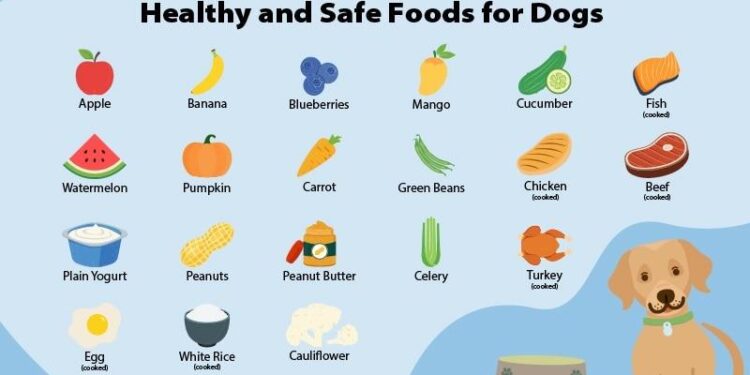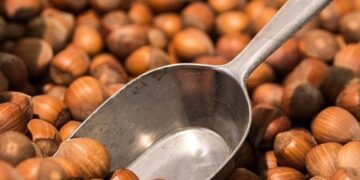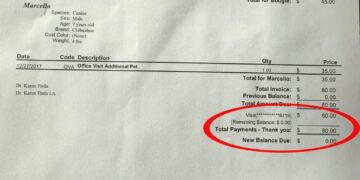Table of Contents
Part 1: The Heartbreak in the Bowl: My Story and the Failure of “Off-the-Rack” Food
Introduction: Pip’s Story
His name was Pip, and he was four pounds of pure, unadulterated joy wrapped in a fawn-colored coat.
When I brought him home, my first Chihuahua, I thought I had it all figured O.T. I bought the softest bed, the tiniest toys, and what I was told was the absolute best, most expensive “premium” dog food on the market.
I was ready to be the perfect dog mom.
But perfection, I soon learned, has very little to do with the price tag on a bag of kibble.
The first year was a blur of vet visits.
It started with the itching—a relentless, frantic scratching that left his delicate skin red and inflamed.
Then came the digestive upset.
One day it was bouts of diarrhea; the next, he’d vomit his entire meal, undigested.
His once-glossy coat became dull and flaky, and his energy, that boundless puppy spark, was fading.1
I stood in my kitchen, looking at this tiny, miserable creature, and felt a wave of helplessness wash over me.
I was doing everything “right.” I was following every piece of conventional advice.
So why was my dog so sick?
That question sent me on a frustrating and expensive quest.
I felt like I was trapped in a revolving door of pet store aisles, each one promising a new miracle.
“Grain-Free” was the first stop.
Then “Limited Ingredient.” Then “Hypoallergenic,” “Vet-Recommended,” and every other marketing buzzword designed to prey on the fears of a desperate owner.
With every new bag of kibble, a flicker of hope would ignite, only to be extinguished a week later when Pip’s symptoms returned, sometimes with a vengeance.
The Vicious Cycle of Premium Kibble
The breaking point came on a Tuesday night.
I had recently switched Pip to a celebrated, grain-free, “hypoallergenic” formula that cost a small fortune.
Friends and online forums raved about it.
This, I was sure, would be the one.
Instead, within a week, Pip’s skin was angrier than ever, and he was seized by a sudden, violent illness.
He was listless, crying in pain, and his little body was rigid.
We rushed to the emergency vet, the sterile smell of the clinic a stark contrast to the panic in my heart.
The diagnosis: acute pancreatitis, a severe inflammation of the pancreas often triggered by dietary fat or an allergic reaction.3
As I sat in the waiting room, the vet’s words echoing in my ears, I had a devastating realization.
The very thing I was buying to make him better was, in fact, making him critically Ill. That bag of scientifically formulated, “perfectly balanced” kibble was poison for him.
This experience, though traumatic, forced me to look beyond the slick marketing and confront the fundamental flaws of a one-size-fits-all approach to canine nutrition, especially for a breed as unique as the Chihuahua.
The problem wasn’t just one bad brand; it was the entire industrial food system.
These mass-produced diets, designed for long shelf life and broad appeal, are often built on a foundation of ingredients that are fundamentally mismatched to a Chihuahua’s sensitive system.
Many are packed with low-quality fillers like corn, wheat, and soy, which serve as cheap protein sources but are notoriously difficult for a small dog’s digestive tract to process.4
Worse, they are often loaded with simple carbohydrates.
While carbs provide energy, excess amounts contribute directly to two of the Chihuahua’s biggest health risks: obesity and dental disease.4
The sticky nature of high-carb foods feeds the bacteria that form plaque, turning your dog’s mouth into a breeding ground for periodontal disease—a condition affecting over 80% of Chihuahuas before the age of two.2
The old myth that crunchy kibble cleans teeth is, for most dogs, simply not true; the kibble often shatters before it can provide any meaningful abrasive action.6
For a breed already predisposed to a host of health vulnerabilities, this “off-the-rack” approach to nutrition is a gamble.
It fails to account for their high metabolism, their tiny stomachs, their crowded teeth, and their propensity for allergies.
I was trying to solve a complex, individual problem with a generic, mass-produced product.
It was never going to work.
Part 2: The Tailor’s Epiphany: A New Blueprint for Canine Nutrition
The “Bespoke Suit” Analogy: My Turning Point
In the quiet days after Pip came home from the emergency vet, weak but recovering, I buried myself in research.
I read veterinary textbooks, nutritional studies, and everything I could find about canine biology.
The answer, however, didn’t come from a scientific journal.
It came from a book I was reading about the history of bespoke tailoring on Savile Row.
The author described the meticulous process: a tailor taking dozens of precise measurements, understanding the client’s posture and lifestyle, selecting the perfect fabric, and then hand-stitching a garment that was a unique extension of the person wearing it.
An off-the-rack suit, no matter how expensive, could never compare.
It was designed for an average, non-existent person and would always pull in some places and sag in others.
It hit me with the force of a physical blow.
That was it.
That was what I had been doing to Pip.
I was trying to force his unique, sensitive, four-pound body into an “off-the-rack” nutritional suit.
Kibble is the off-the-rack suit of the dog food world.
It’s designed for the “average” dog, but just like in humans, the “average” dog doesn’t really exist.
My entire paradigm shifted.
My goal was no longer to find the right brand of food.
My goal was to become the tailor.
I needed to stop shopping and start building.
I needed to create a bespoke diet, crafted from a unique nutritional blueprint designed for one client and one client only: Pip.
This analogy became my guiding principle, the framework that allowed me to move from a state of helpless frustration to empowered action.
It’s the same framework I now use as a certified canine nutritionist, and it’s the one I want to share with you.
It’s built on three pillars: taking the measurements, selecting the fabric, and mastering the art of the stitch.
Pillar 1: Taking Your Dog’s Measurements – The Chihuahua Nutritional Blueprint
Before a tailor ever touches fabric, they must understand the body they are fitting.
For us, this means understanding the unique and often delicate biology of the Chihuahua.
They are not simply scaled-down versions of larger dogs; their physiology is distinct and demands a specialized approach.
First and foremost is their metabolism.
A Chihuahua’s engine runs hot.
Compared to a large breed like a Great Dane, a Chihuahua burns far more calories per pound of body weight just to stay alive.8
This high metabolic rate has a critical consequence: they are highly susceptible to
hypoglycemia, a dangerous drop in blood sugar.1
If they go too long without eating, their tiny bodies simply don’t have the energy reserves to maintain stable glucose levels.
This is why feeding an adult Chihuahua just once a day is a recipe for disaster.
They require smaller, calorie-dense meals spread throughout the day—at least two, and ideally three—to keep their blood sugar stable.1
The warning signs of hypoglycemia are terrifying and can include a wobbly gait, lethargy, muscle twitching, restlessness, and even seizures.1
A diet designed for them must be structured to prevent this at all costs.
Their macronutrient needs are also specific.
To support their surprisingly high percentage of lean muscle mass, their diet should consist of 20-30% high-quality, easily digestible protein.4
Healthy fats are equally vital, serving as a concentrated source of energy and providing the essential omega-3 and omega-6 fatty acids that reduce inflammation and are crucial for maintaining healthy skin and a glossy coat.4
Carbohydrates, on the other hand, should be limited and sourced carefully from complex, whole-food sources to provide sustained energy without contributing to weight gain or dental decay.4
Understanding these measurements reveals a critical truth about the breed: they are prone to what I call the “Fragility Cascade.” Their health issues are rarely isolated; they are an interconnected series of vulnerabilities where one problem triggers or exacerbates another.
It starts in the mouth.
Their small jaws and disproportionately large teeth lead to severe overcrowding, creating perfect traps for food and plaque.2
This makes them exceptionally prone to periodontal disease.
But this isn’t just about bad breath or tooth loss.
The chronic inflammation and bacteria from diseased gums can enter the bloodstream, traveling through the body and damaging vital organs like the heart, kidneys, and liver.2
This is particularly alarming given that congestive heart failure is a leading cause of death in older Chihuahuas.2
Simultaneously, their delicate frame makes them susceptible to orthopedic issues like patellar luxation (slipping kneecaps) and tracheal collapse (a weakening of the windpipe).2
Both of these conditions are made exponentially worse by even a small amount of excess weight.
An extra pound on a six-pound dog is the equivalent of an extra 25-30 pounds on a person—a massive strain on their tiny joints and airway.1
And what is a primary driver of this dangerous weight gain? Overfeeding and high-carbohydrate diets, the very hallmarks of many commercial kibbles.3
This is the cascade: a high-carb diet contributes to dental disease, which in turn can damage the heart.
That same diet can lead to obesity, which places crippling stress on already fragile joints and airways.
You are not just fighting one problem at a time; you are fighting a systemic, interconnected web of fragility.
The profound power of a bespoke, homemade diet is that it acts as a single, decisive point of intervention.
By precisely controlling every ingredient, you can disrupt the entire cascade—managing weight, reducing inflammation, supporting joint health, and starving the bacteria that cause dental disease, all in a single bowl.
| Table 1: The Chihuahua Health & Diet Matrix |
| Common Health Issue |
| Hypoglycemia (Low Blood Sugar) |
| Periodontal Disease |
| Obesity |
| Patellar Luxation & Tracheal Collapse |
| Skin Allergies & Sensitivities |
| Heart Disease |
Pillar 2: Selecting the Fabric – The Whole-Food Pantry
With our dog’s unique measurements in hand, the next step is to select the highest quality materials.
A bespoke suit made from cheap polyester will still be a cheap suit.
Likewise, our bespoke diet must be built from a pantry of fresh, vibrant, whole foods.
Proteins: The Foundational Weave
Protein is the cornerstone of the diet.
It provides the essential amino acids necessary for everything from muscle maintenance to immune function.17 For most Chihuahuas, excellent choices include lean, cooked meats like
chicken (thigh meat is more nutrient-dense than breast), turkey, lean ground beef (90% lean or higher), and certain types of fish.4
However, for dogs like Pip who suffer from allergies, this is where the bespoke approach truly shines.
Food allergies in dogs are an immune response, most often to proteins they have been repeatedly exposed to.
The most common culprits are beef, chicken, dairy, and wheat.16
By preparing the food yourself, you can introduce “novel proteins”—meats your dog has likely never encountered before, such as
venison, duck, rabbit, or bison.
Because their immune system doesn’t recognize these proteins as a threat, they are far less likely to trigger an allergic reaction, providing immense relief for dogs with itchy skin and digestive upset.15
Fats: The Luxurious Lining
Healthy fats are not to be feared; they are essential.
They are the most concentrated source of energy in the diet and are critical for absorbing fat-soluble vitamins.21 Most importantly, they are the source of essential fatty acids, particularly
Omega-3s (like EPA and DHA) and Omega-6s.
While both are necessary, the modern canine diet is often overloaded with inflammatory Omega-6s (found in corn oil and chicken fat) and deficient in anti-inflammatory Omega-3s.
Correcting this balance is one of the most powerful things you can do for your Chihuahua’s health.
Excellent sources of Omega-3s include fish oil (from salmon, sardines, or krill), flaxseed oil, and coconut oil.
These fats help to reduce inflammation throughout the body, which can soothe itchy skin, support joint health, and promote cognitive function.4
Carbohydrates: The Structural Thread
While dogs have no strict dietary requirement for carbohydrates, they can be a valuable source of energy and fiber when chosen wisely and used in moderation.17 The key is to avoid the simple, starchy fillers found in kibble and instead opt for complex, low-glycemic carbohydrates.
These break down slowly, providing sustained energy without causing sharp spikes in blood sugar.
Excellent choices include
sweet potatoes, pumpkin, quinoa, and small amounts of brown rice or oats.4
These ingredients are also rich in fiber, which is crucial for maintaining a healthy digestive system.17
Vegetables & Fruits: The Vibrant Accents
Fresh vegetables and fruits are the nutritional powerhouses of a homemade diet.
They provide a rich array of vitamins, minerals, antioxidants, and fiber.
Dog-friendly options include carrots, green beans, broccoli, spinach (in moderation), and zucchini.
Fruits like blueberries (packed with antioxidants) and small pieces of apple (seeds and core removed) can be wonderful additions.13 These ingredients not only boost the nutritional profile of the meal but also add texture and flavor that can entice even the pickiest of eaters.
Building this pantry requires vigilance.
Our human kitchens contain many ingredients that are perfectly safe for us but dangerously toxic to dogs.
A bespoke diet is an act of love, and that love must include protecting them from accidental poisoning.
| Table 2: The Chihuahua’s Safe & Toxic Foods List |
| Safe Foods in Moderation |
| Proteins: Cooked chicken, turkey, lean beef, lamb, pork, salmon, whitefish, eggs. 23 |
| Vegetables: Carrots, green beans, peas, sweet potatoes, pumpkin, broccoli, celery, spinach. 23 |
| Fruits: Apples (no seeds/core), blueberries, bananas, watermelon (no rind/seeds), strawberries. 23 |
| Carbohydrates: Brown rice, white rice, quinoa, oats, pasta, potatoes (cooked). 23 |
| Dairy: Plain yogurt, kefir, cottage cheese (in small amounts, as some dogs are lactose intolerant). 13 |
Pillar 3: The Art of the Stitch – Achieving Perfect Balance and Safety
This is the most critical and often most intimidating part of the process.
It’s where we take our beautiful, high-quality ingredients and stitch them together into a complete, balanced, and safe garment.
The single greatest risk of a homemade diet—and the reason many veterinarians are hesitant to recommend them—is the potential for nutritional imbalance.
A 2013 study from UC Davis found that 95% of 200 homemade dog food recipes analyzed were deficient in at least one essential nutrient.29
This is a sobering statistic, and it highlights a crucial point: you cannot simply mix meat, rice, and carrots and call it a day.
Doing so over the long term is dangerous and can lead to severe health problems.
This brings us to a paradox.
We know that most homemade recipes are deficient, yet countless owners (myself included) have witnessed dramatic, life-changing health improvements after switching from a “complete and balanced” commercial kibble.
How can this be? The answer lies in redefining our understanding of “balance.” The balance found in a bag of kibble is a static balance.
It’s a formula engineered by food scientists to meet the minimum nutritional standards set by the Association of American Feed Control Officials (AAFCO) for a hypothetical “average” dog, and to remain stable in a bag for 12-18 months.29
It is a population-level standard designed to prevent widespread deficiency.
The bespoke diet, however, aims for a dynamic balance.
This is a higher standard.
It means creating a diet that not only meets those baseline AAFCO minimums but is actively tailored to support, correct, and optimize the health of your individual dog.
It’s a diet that can be adjusted to include more anti-inflammatory Omega-3s for a dog with arthritis, or one that uses a novel protein to calm the immune system of a dog with allergies.
Achieving this dynamic balance is not a matter of guesswork.
It requires precision.
It requires the final, non-negotiable step in our tailoring process: supplementation.
Think of supplements as the fine, invisible stitching that holds the entire garment together, ensuring its strength and integrity.
Cooking for your dog without them is like sewing a suit with thread that will dissolve in the rain.
There are three core supplements that are almost universally required to make a homemade diet complete:
- Calcium: This is the most critical supplement. Meat is very high in phosphorus, and a diet with an improper calcium-to-phosphorus ratio can, over time, pull calcium from your dog’s bones, leading to severe orthopedic problems.14 You must add a source of calcium, such as plain calcium carbonate or finely ground eggshells, to balance the phosphorus in the meat. The ideal ratio of calcium to phosphorus (
Ca:P) is between 1:1 and 2:1.31 - Omega-3 Fatty Acids: As discussed, even with fish in the recipe, it is difficult to provide a therapeutic, anti-inflammatory dose of EPA and DHA without supplementation. A high-quality fish or krill oil is essential for managing inflammation, which is at the root of so many Chihuahua health issues.14
- A Multivitamin & Mineral Blend: This is the safety net that fills in all the other nutritional gaps. Cooking can degrade certain vitamins (like B vitamins), and it’s nearly impossible to hit the required targets for trace minerals like zinc, copper, and iodine through food alone.17 Using a reputable, pre-formulated vitamin and mineral blend designed specifically for homemade dog food is the safest and easiest way to ensure your dog’s diet is truly complete. Companies like Balance IT and Just Food For Dogs offer nutrient blends that are formulated by veterinary nutritionists to meet AAFCO standards when added to specific recipes.14
Supplementation is not an optional “booster.” It is the fundamental component that transforms a simple meal of “meat and vegetables” into a nutritionally complete, life-sustaining diet.
It is the final, precise step that makes our bespoke creation not just beautiful, but perfectly functional.
| Table 3: Core Supplements for a Complete Homemade Diet |
| Supplement Type |
| Calcium (e.g., Calcium Carbonate, Ground Eggshell) |
| Omega-3 Fatty Acids (e.g., Fish Oil, Krill Oil) |
| Vitamin & Mineral Blend (e.g., Balance IT, Just Food For Dogs Nutrient Blend) |
| (Optional) Probiotics & Prebiotics |
| (Optional) Joint Support (e.g., Glucosamine, Chondroitin) |
Part 3: The Bespoke Kitchen: Vet-Approved Recipes and Practical Guidance
Before You Begin: Kitchen Safety and Prep
Welcome to your dog’s new personal kitchen.
Your role as their chef comes with the responsibility of ensuring every meal is not only nutritious but also safe.
Food safety is paramount.
Always handle raw meats with care to avoid cross-contamination with other foods or surfaces in your kitchen.
Use separate cutting boards for meat and produce, and wash your hands, utensils, and countertops thoroughly after handling raw ingredients.37
Cook all animal proteins to a safe internal temperature to eliminate harmful bacteria like Salmonella and E.
coli.27
Recipe 1: The Foundation Recipe for a Thriving Chihuahua
This recipe is a balanced, foundational meal designed for a generally healthy adult Chihuahua.
It uses accessible, high-quality ingredients and provides a fantastic starting point for your homemade journey.
This recipe makes a batch that can be portioned and stored.
Note: All measurements are for uncooked ingredients unless specified.
A kitchen scale is highly recommended for accuracy.
Ingredients:
- 450g (1 lb) 90% lean ground turkey 39
- 100g (approx. ½ cup) brown rice 39
- 120g (approx. 1 cup) finely chopped carrots 39
- 120g (approx. 1 cup) chopped green beans 18
- 60g (approx. ½ cup) spinach 39
- 1 tablespoon flaxseed oil or salmon oil 34
- Essential Supplements: Calcium and a vitamin/mineral blend, dosed according to your vet’s recommendation or the product’s instructions for this amount of food.
Instructions:
- Cook the brown rice according to package directions using water (no salt or oil). Set aside.
- In a large skillet or pot, cook the ground turkey over medium heat until it is fully browned. Break it up into small crumbles as it cooks. Drain off any excess fat.39
- While the turkey is cooking, steam or lightly boil the carrots and green beans until they are tender but not mushy. This makes them easier to digest.
- Once the turkey is cooked, reduce the heat to low. Add the cooked rice, steamed vegetables, and fresh spinach to the pot. Stir until the spinach has wilted.39
- Remove the pot from the heat and allow the mixture to cool to room temperature. It is critical that the food is cool before adding supplements, as heat can degrade sensitive vitamins and oils.
- Once cool, thoroughly mix in the flaxseed/salmon oil and the required amounts of your calcium and vitamin/mineral supplements.
- Portion the food into daily or single-meal servings in airtight containers. Refrigerate what you will use in the next 3-4 days and freeze the rest.35
Recipe 2: The “Sensitive Soul” Recipe for Allergies & Upset Stomachs
This recipe was inspired by Pip.
It is designed for Chihuahuas with suspected food allergies or sensitive digestive systems.
It uses a novel protein (venison) and easily digestible carbohydrates, along with ingredients to soothe the gut.
Ingredients:
- 450g (1 lb) ground venison or duck 15
- 250g (approx. 1 large) sweet potato, peeled and diced 15
- 150g (approx. 1 cup) 100% pure canned pumpkin puree (NOT pumpkin pie filling) 22
- 60g (approx. ½ cup) chopped zucchini 22
- 1 tablespoon coconut oil (for its anti-inflammatory properties) 15
- Essential Supplements: Calcium and a vitamin/mineral blend, dosed according to instructions.
Instructions:
- Boil or steam the diced sweet potato until it is very tender. Mash it with a fork and set aside.
- In a large skillet, cook the ground venison or duck over medium heat until fully browned. Drain any excess fat.
- Steam the chopped zucchini until tender.
- Remove the skillet from the heat. Add the mashed sweet potato, steamed zucchini, and pumpkin puree to the cooked meat. Stir everything together until well combined.
- Allow the mixture to cool completely to room temperature.
- Once cool, thoroughly mix in the coconut oil and the required amounts of your calcium and vitamin/mineral supplements.
- Portion and store as described in the first recipe.
Portioning, Transitioning, and Monitoring
Portioning: This is where precision prevents problems.
Overfeeding a small dog is incredibly easy and leads directly to obesity and the “Fragility Cascade.” Do not guess or use measuring cups.
Use a kitchen scale. A Chihuahua’s daily caloric needs can range from about 150 to 400 calories depending on their weight, age, and activity level.9
Your veterinarian can help you determine a precise target.
The table below provides a general starting point for the recipes above (which contain approximately 1.5 kcal per gram).
You must monitor your dog’s body condition and adjust as needed.
| Table 4: Daily Feeding Guide for Chihuahuas (in Grams) |
| Dog’s Weight |
| 2 lbs / 0.9 kg |
| 4 lbs / 1.8 kg |
| 6 lbs / 2.7 kg |
| 6 lbs / 2.7 kg |
| 8 lbs / 3.6 kg |
| 8 lbs / 3.6 kg |
| 10 lbs / 4.5 kg |
| 10 lbs / 4.5 kg |
Transitioning: Never switch your dog’s food abruptly.
This can cause severe digestive upset.
Transition slowly over 7-10 days to allow their system to adapt.18
- Days 1-3: 75% old food, 25% new homemade food.
- Days 4-6: 50% old food, 50% new homemade food.
- Days 7-9: 25% old food, 75% new homemade food.
- Day 10: 100% new homemade food.
Monitoring: Become a student of your dog.
After the transition, pay close attention to their body’s feedback.
- Stool Quality: Stools should be firm, well-formed, and consistent. Diarrhea or constipation may indicate an ingredient sensitivity or that the transition was too fast.1
- Energy & Demeanor: A well-nourished dog should have bright eyes and consistent, happy energy levels.
- Skin & Coat: Over several weeks, you should notice improvements in skin health (less itching, redness) and coat quality (increased shine, less flaking).2
- Body Weight: Weigh your dog weekly. If they are unintentionally gaining or losing weight, adjust their portion size by 10% and continue to monitor.17 This is the essence of dynamic balance—adjusting the “fit” of the diet as needed.
Part 4: Your New Journey: From Helpless Owner to Empowered Advocate
Conclusion: Pip’s Transformation and Your Path Forward
I will never forget the day, about a month after I started meticulously preparing Pip’s “bespoke” meals, that I realized he had stopped scratching.
The frantic, all-consuming itch that had tormented him for years was just… gone.
His coat, once so dull, was growing in with a deep, glossy shine.
The chronic diarrhea had vanished, replaced by predictable, healthy digestion.
He was playing again, chasing his tiny toys with an energy I hadn’t seen since he was a puppy.
It was like watching a flower, long wilted, finally turn towards the Sun. He was transformed.
Pip lived for many more happy, vibrant years, free from the chronic ailments that had once defined his existence.
That journey, born of desperation in my own kitchen, is what led me to become a certified canine nutritionist.
It taught me that the most powerful tool we have to influence our dogs’ health isn’t in a pill bottle or a fancy bag from the pet store; it’s in their food bowl.
Making the switch to a homemade diet is a commitment.
It requires time, research, and a partnership with your veterinarian.
It asks you to become more than just an owner; it asks you to become your dog’s personal chef, their nutritionist, and their most dedicated health advocate.
But as I learned with Pip, this effort is not a chore.
It is the single most profound and direct way to express your love.
It is the act of taking back control from a commercial system that may not have your dog’s best interests at heart and placing their well-being squarely in your own capable hands.
I started this journey exactly where you might be now: worried, frustrated, and feeling helpless.
I want you to know that you are not helpless.
You have the power to change your dog’s life.
The path begins not in the pet food aisle, but in your own kitchen, with a simple, powerful idea: to craft a diet as unique, as special, and as deserving of care as the little dog who is waiting for their dinner.
Works cited
- Diet & Nutrition Guide: Chihuahuas – PetPlate, accessed August 16, 2025, https://origin-prod-wpengine.petplate.dev/blog/diet-nutrition-guide-chihuahuas/
- Chihuahua Health | Schedule Your Pet’s Check-Up & Vaccinations Today – Asavet Charities, accessed August 16, 2025, https://www.asavetcharities.org/common-chihuahua-health-issues/
- 5 Common Dog Illnesses that are Impacted by Nutrition – PetMD, accessed August 16, 2025, https://www.petmd.com/dog/centers/nutrition/dog-diarrhea-and-other-diseases-impacted-by-nutrition
- Nutritional Tips for Chihuahuas – Evanger’s Dog Food, accessed August 16, 2025, https://evangersdogfood.com/nutritional-tips-for-chihuahuas/
- Chihuahua Dog Breed Health and Care – PetMD, accessed August 16, 2025, https://www.petmd.com/dog/breeds/chihuahua
- Best Food for Canines Dental Health | Ruckersville Vets, accessed August 16, 2025, https://www.rvilleah.com/site/blog/2023/03/30/best-food-canine-dental-health
- Dogs, Nutrition, and Periodontal Disease | VCA Animal Hospitals, accessed August 16, 2025, https://vcahospitals.com/know-your-pet/dogs-nutrition-and-periodontal-disease
- Diets for Small Dogs – Whole Dog Journal, accessed August 16, 2025, https://www.whole-dog-journal.com/food/diets-for-small-dogs/
- Nutritional Differences for Small, Toy, and Large Breed Dogs – PetMD, accessed August 16, 2025, https://www.petmd.com/blogs/nutritionnuggets/jcoates/2012/feb/nutrition_differences_for_small_toy_large_breeds-12459
- Nutritional Needs for Small and Large Breed Dogs | Sandy Paws Animal Hospital, accessed August 16, 2025, https://www.sandypawsanimalhospital.com/blog/nutritional-needs-for-small-and-large-breed-dogs-sandy-paws-animal-hospital
- The Nutritional Needs of Small Breeds – Blue Buffalo, accessed August 16, 2025, https://www.bluebuffalo.com/articles/dog/the-nutritional-needs-of-small-breeds/
- The Best Diet to Improve Your Dog’s Dental Health | Hopkinsville – Skyline Animal Clinic, accessed August 16, 2025, https://www.skylineanimalclinic.net/site/blog/2024/04/15/best-food-canines-dental-health
- How To Add Critical Supplements to Homemade Dog Food – Rover.com, accessed August 16, 2025, https://www.rover.com/blog/homemade-dog-food-supplements/
- Homemade Dog Food for Skin Allergies: Expert Guide | Holistic Vet Blend, accessed August 16, 2025, https://holisticvetblend.com/blogs/news/homemade-dog-food-for-skin-allergies-expert-guide
- Choosing the Right Food for Dogs with Skin Allergies – Simply Naked Pet Food, accessed August 16, 2025, https://simplynakedpetfood.com/blogs/fish-based-pet-food-resources/food-for-dogs-with-skin-allergies
- Homemade Dog Food Recipes: Choosing Balanced Ingredients, accessed August 16, 2025, https://www.akc.org/expert-advice/nutrition/choosing-ingredients-homemade-dog-food/
- Delicious and Nutritious Dog Food Recipes for Small Dogs | Houndsy, accessed August 16, 2025, https://www.houndsy.com/blogs/modern-tails/delicious-and-nutritious-dog-food-recipes-for-small-dogs
- Food Allergies in Dogs: Does My Dog Have Food Allergies? – MedVet, accessed August 16, 2025, https://www.medvet.com/food-allergy-dog/
- Best Food for Dogs With Allergies | Thornton Vet – Caring Hands Veterinary Hospital, accessed August 16, 2025, https://www.denvervet.com/site/blog/2021/12/30/best-food-for-dogs-with-allergies
- Dog Nutrition: Guide to Dog Food Nutrients – PetMD, accessed August 16, 2025, https://www.petmd.com/dog/nutrition/evr_dg_whats_in_a_balanced_dog_food
- Easy Homemade Dog Food Recipe | This Mess is Ours, accessed August 16, 2025, https://thismessisours.com/easy-homemade-dog-food-recipe/
- Human Foods Dogs Can Eat: Complete List | The Vets, accessed August 16, 2025, https://thevets.com/resources/pet-nutrition/human-food-dogs-can-eat/
- People Foods to Avoid Feeding Your Pets – ASPCA, accessed August 16, 2025, https://www.aspca.org/pet-care/aspca-poison-control/people-foods-avoid-feeding-your-pets
- Homemade vs. Store Bought Pet Food: Which Should You Choose?, accessed August 16, 2025, https://rrvet.com/homemade-vs-store-bought-pet-food-which-should-you-choose/
- Kibble vs Homemade Dog Food – ChefPaw, accessed August 16, 2025, https://www.chefpaw.com/blogs/news/kibble-vs-homemade-dog-food
- Nutritional Requirements of Small Animals – Management and …, accessed August 16, 2025, https://www.merckvetmanual.com/management-and-nutrition/nutrition-small-animals/nutritional-requirements-of-small-animals
- Dog Supplements for Homemade Food | JustFoodforDogs Blog, accessed August 16, 2025, https://blog.justfoodfordogs.com/dog-supplements-for-homemade-food.html
- Best Dog Vitamins For Homemade Dog Food – Paramount Pet Health, accessed August 16, 2025, https://www.paramountpethealth.com/blogs/articles/best-dog-vitamins-for-homemade-dog-food
- Homemade dog food: a super guide for everything you need to know + 10 recipes, accessed August 16, 2025, https://colaskitchen.com/blog-posts/homemade-dog-food-a-super-guide-for-everything-you-need-to-know-10-recipes
- Vet-Approved Homemade Dog Food Recipes – The Spruce Pets, accessed August 16, 2025, https://www.thesprucepets.com/homemade-dog-food-recipes-5200240
- Is Homemade Dog Food Right for Your Pet? The Pros, Cons, & Recipes – Florida Animal Friend, accessed August 16, 2025, https://floridaanimalfriend.org/blog-post/is-homemade-dog-food-right-for-your-pet-the-pros-cons-recipes/
- Fresh vs Raw Dog Food vs Kibble: Which Diet Is Best For Your Dog? – American Kennel Club, accessed August 16, 2025, https://www.akc.org/expert-advice/nutrition/fresh-raw-kibble-dog-food/
- DIY Homemade Dog Food – Damn Delicious, accessed August 16, 2025, https://damndelicious.net/2015/04/27/diy-homemade-dog-food/






